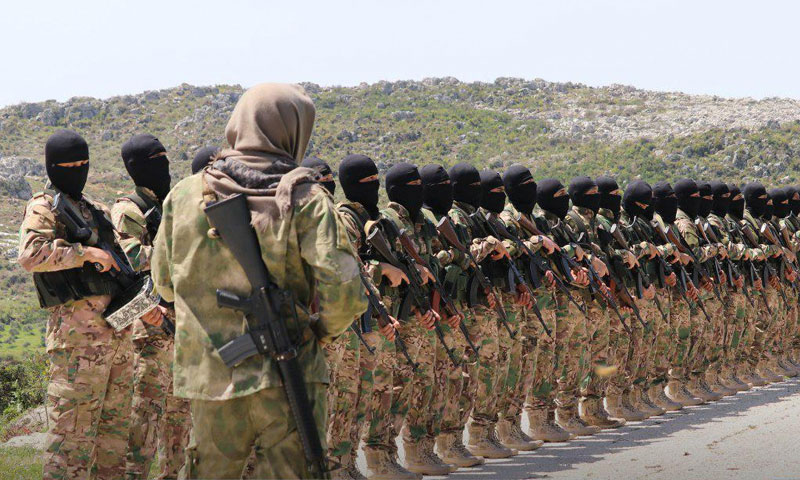The United States has placed Syrian figures on its most-wanted list, offering millions of U.S. dollars for information leading to the identification and location of the three jihadists.
The figures are directly linked to jihadist organizations fighting in Syria, under several names, most notably Hurras al-Din (HAD), and Hay’at Tahrir al-Sham (HTS), which were listed by Washington as terrorist organizations.
Al-Jawlani
Abu Mohammad al-Jawlani, the leader of HTS, is on the US’s most wanted list. Washington offered a reward of up to 10 million USD for information leading to his capture. According to the State Department’s digital outreach team, al-Jawlani was born in Syria between 1975 and 1979. Al-Jawlani, who hails from the Golan Heights region, moved to Iraq after the US invasion in 2003 and fought within the ranks of al-Qaeda. He worked under the leadership of Abu Musab al-Zarqawi and his successors. After the outbreak of the Syrian revolution, he headed to Syria to found the al-Nusra Front and pledged allegiance to al-Qaeda and its leader Ayman al-Zawahiri.
In July 2016, al-Jawlani announced that al-Nusra disengaged from al-Qaeda and changed its name to Jabhat Fateh al-Sham. Then, it merged with several factions in January 2017 to become the HTS.
According to the outreach team, al-Nusra Front, from which Tahrir al-Sham (HTS) was formed, is still affiliated to al-Qaeda in Syria. However, HTS has repeatedly denied any links to al-Qaeda, stressing that it is fighting the Syrian regime. HTS controls large areas of Idlib and its countryside as well as areas in the countryside of Latakia.
Faruq al-Suri
Faruq al-Suri was born in 1977 and is also known as Samir Hijazi and Abu Humam al-Shami. He is the current leader of Hurras al-Din (HAD). HAD has always been the branch of al-Qaeda in Syria although the latter did not officially announce that it had military roots in Syria. However, in 2018 al- Qaeda’s General Command issued a statement that clearly affirmation the deployment of its operatives in Syria for the first time after al-Nusra Front disengaged.
According to information obtained by Enab Baladi, HAD includes the following military groups: Army of Malahem, Army of al-Sahel, Army of al-Badia, Saraya al-Sahel, Sariyat Kabil, Jund al-Sharia, and remnants of Jund al-Aqsa. They are led by the former leader of HTC, Abu Humam al-Shami in partnership with the leaders of the al-Qaeda in the Shura Council, including: Abu Jleibib Tubas, Abu Khadija al-Urduni, Sami al-Aridi, Abu al-Qassam, Abu Abdul Rahman al-Makki, as well as a number of former leaders in al-Nusra Front who refused to disengage from the al-Qaeda.
Washington has established a reward of 5 million USD for information on Faruq al-Suri. According to the outreach team, al-Suri was a senior paramilitary trainer with al-Qaeda’s senior commander, Sayf al-Adl, in Afghanistan in the 1990s. Faruq al-Suri trained al-Qaeda fighters in Iraq from 2003 to 2005. He was previously detained in Lebanon from 2009 to 2013. After that al-Suri joined al-Nusra Front and became its military commander before leaving it in 2016. In September 2019, the US designated al-Suri as an international terrorist.
Yasin al- Suri
Ezzeddin Abdel Aziz Khalil, more commonly known as Yasin al- Suri, was born in Qamishli in 1982 and is considered a senior al-Qaeda facilitator.
According to the US outreach team, al-Suri is “responsible for overseeing al-Qaida efforts to transfer experienced operatives and leaders from Pakistan to Syria, organizing and maintaining routes by which new recruits can travel to Syria via Turkey, and assisting in the movement of al-Qaida external operatives to the West.”
Al-Suri also contributes to fundraising for al- Qaeda and transfers it through Iran, to support al-Qaeda’s senior leadership in Afghanistan and Iraq.
Washington offered a 10 million USD reward for information about Yusin al-Suri, prompting Iran to arrest him in December 2011, according to the outreach team. The US claims that Yusin al-Suri has resumed leadership of al-Qaeda’s Iran-based network while Iran denied his presence on its territory in December 2011.











